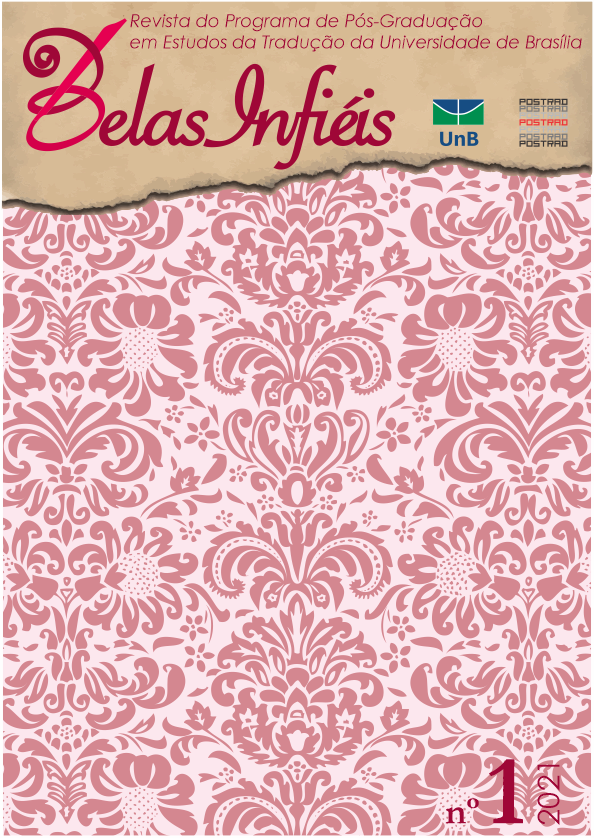The deaf and hearing dichotomy in the translation of classic tales according to deaf culture: a subversive strike back throughout appropriation?
DOI:
https://doi.org/10.26512/belasinfieis.v10.n1.2021.32648Keywords:
Literature translation. Printed Deaf Literature. Cultural identities. Literature and translation. Deaf identity.Abstract
From time to time, deafness has been mistaken as a limitation, an illness or even a punishment, delegating to deaf people peripheral conditions conditioned by the hegemonic power of each given context. However, in the present moment we realize the awakening of a deaf consciousness, a search for identity assertion, and the translated literature ”“ considered here as a mean of symbolic expression and the product of identities capable of constructing socially and recognizable meanings in the circles in which it circulates ”“ acts as an important tool of socio-political and educational empowerment of the deaf. Therefore, this article, as an important part of the Marster’s Thesis entitled The translation of popular classic tales with defined scopes: a tour throughout the printed ver From time to time, deafness has been mistaken as a limitation, an illness or even a punishment, delegating to deaf people peripheral conditions conditioned by the hegemonic power of each given context. However, in the present moment we realize the awakening of a deaf consciousness, a search for identity assertion, and the translated literature ”“ considered here as a mean of symbolic expression and the product of identities capable of constructing socially and recognizable meanings in the circles in which it circulates ”“ acts as an important tool of socio-political and educational empowerment of the deaf. Therefore, this article, as an important part of the Marster’s Thesis entitled The translation of popular classic tales with defined scopes: a tour throughout the printed versions of Deaf Cinderella (2003), Deaf Rapunzel (2003) and Deaf Duck (2005) (UEM), is aimed at reflecting upon the classic tales translated according to the deaf culture in the books Deaf Cinderella (HESSEL; KARNOPP; ROSA, 2003), Deaf Rapunzel (KARNOPP; ROSA; SILVEIRA, 2003) and Deaf Duck (KARNOPP; ROSA, 2005). In addition, based on the studies of Venuti (2002), we investigate the representation of the cultural identities that were built within the translation process.sions of Deaf Cinderella (2003), Deaf Rapunzel (2003) and Deaf Duck (2005) (UEM), is aimed at reflecting upon the classic tales translated according to the deaf culture in the books Deaf Cinderella (HESSEL; KARNOPP; ROSA, 2003), Deaf Rapunzel (KARNOPP; ROSA; SILVEIRA, 2003) and Deaf Duck (KARNOPP; ROSA, 2005). In addition, based on the studies of Venuti (2002), we investigate the representation of the cultural identities that were built within the translation process.
Downloads
References
Afanas’ev, A. (2003). Contos de fadas russos. (D. A. Azevedo, Trans.). São Paulo: Landy Editora.
Alves, E. R. F. (2006). Outremização e revide de colonizado e colonizador em The Narrative of Jacobus Coetzee (1974), de J. M. Coetzee. 2006. 192 f. [Dissertação de Mestrado – Universidade Estadual de Maringá, Maringá].
Andersen, H. C. (2010). The ugly duck and other tales. Withefish: Kessinger.
Asbjørsen, P. C., Moe, J. (1859). Popular Tales from the Norse, (2. ed., pp. 411-428). (G. W. Dasent, Trans.). Edinburgh: Edmonston and Douglas.
Asbjørsen, P. C., MOE, J. (2013). Por que o mar é salgado: contos populares da Noruega. (K. L. Garrubo, Trans.). São Paulo: Berlendis.
Ashcroft, B., Griffiths, G., Tiffin, H. (1991). The empire writes back. New York: Routledge.
Bettelheim, B. (1980). A psicanálise dos contos de fadas. (A. Caetano, Trans.). Rio de Janeiro: Paz e Terra.
Bonnici, T. (2000). O pós-colonialismo e a literatura: estratégias de leitura. Maringá: EDUEM.
Grimm, W., Grimm, J. (1991). Contos de Grimm. (M. H. Penteado, Trans.). (2. ed., Vol. 2). São Paulo: Ática, 1991.
Grimm, W., Grimm, J. (2012). Grimm’s complete fairy tales. New York: Barnes&Noble.
Hermans, T. (1996). Translation’s other. London: University College.
Hessel, C., Karnopp, L. B., Rosa, F. (2003). Cinderela Surda. Canoas: ULBRA.
Karnopp, L. B., Rosa, F. (2005). Patinho Surdo. Canoas: Ed. ULBRA.
Karnopp, L. B., Rosa, F., Silveira, C. H. (2003). Rapunzel Surda. Canoas: ULBRA.
La Force, C. R. C. (2014) Persinette, the maiden in the tower. (R. L. Lawrence, Trans.). (Kindle Edition). Blackdown Publications.
Perrault, C. (1989). Contos de Perrault. (R. R. Junqueira, Trans.). (2. ed.). Belo Horizonte: Itatiaia.
Pratt, M. L. (1999). Os olhos do império. Bauru: USC.
Sousa, D. V. C. Língua Brasileira de Sinais e Língua de Sinais Francesa: uma relação histórica, linguística e cultural. http://www.brasilazur.com/2012/09/linguabrasileira-de-sinais-e-lingua-de-sinais-francesa-uma-relacao-historica-linguistica-e-cultural/. Recuperado em julho de 2020.
Spivak, G. C. (1985). The rani of sirmur: an essay in reading the archives. History and Theory, 24(3), 247-272.
Spivak, G. C. (1995). Can the subaltern speak? In B. Ashcroft, G. Griffiths & H. Tiffin. The post-colonial studies reader (pp. 24-28). London: Routledge.
Tatar, M. (Org.). Contos de fadas: edição comentada e ilustrada. (M. L. X. A. Borges, Trans.). Rio de Janeiro: Jorge Zahar Ed.
Venuti, L. (2002). Escândalos da Tradução. (L. Pelegrini et al. Trans.). Bauru: EDUSC.
Downloads
Published
How to Cite
Issue
Section
License
Copyright (c) 2021 CC BY

This work is licensed under a Creative Commons Attribution 4.0 International License.
Given the public access to this journal, the texts are free to use but requires the recognition of the original authorship and initial publication in this journal to be properly stated.
 The journal allows the use of works published for non-commercial purposes, including the right to submit the work to publicly accessible databases. Published contributions are the sole and exclusive responsibility of the author(s).Â



















